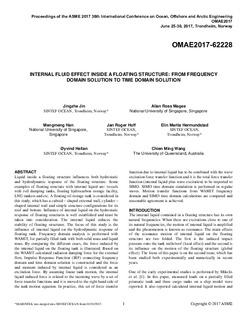| dc.contributor.author | Jin, Jingzhe | |
| dc.contributor.author | Magee, Allan Ross | |
| dc.contributor.author | Han, Mengmeng | |
| dc.contributor.author | Hoff, Jan Roger | |
| dc.contributor.author | Hermundstad, Elin Marita | |
| dc.contributor.author | Hellan, Øyvind | |
| dc.contributor.author | Wang, Chien Ming | |
| dc.date.accessioned | 2017-11-21T07:38:44Z | |
| dc.date.available | 2017-11-21T07:38:44Z | |
| dc.date.created | 2017-11-16T12:49:21Z | |
| dc.date.issued | 2017-06-25 | |
| dc.identifier.citation | ASME 2017 36th International Conference on Ocean, Offshore and Arctic Engineering - Volume 7B: Ocean Engineering | nb_NO |
| dc.identifier.isbn | 978-0-7918-5774-8 | |
| dc.identifier.uri | http://hdl.handle.net/11250/2467241 | |
| dc.description.abstract | Liquid inside a floating structure influences both hydrostatic and hydrodynamic response of the floating structure. Some examples of floating structure with internal liquid are: vessels with roll damping tanks, floating hydrocarbon storage facility, LNG tankers and etc. A floating oil storage tank is considered in this study, which has a cuboid-shaped external wall, cylinder-shaped internal wall and simple structure configurations for its roof and bottom. Influence of internal liquid on the hydrostatic response of floating structures is well established and must be taken into consideration. The internal liquid reduces the stability of floating structures. The focus of this study is the influence of internal liquid on the hydrodynamic response of floating tank. Frequency domain analysis is performed with WAMIT, for partially filled tank with both solid mass and liquid mass. By comparing the different cases, the force induced by the internal liquid on the floating tank is illustrated. Based on the WAMIT calculated radiation damping force for the external flow, Impulse Response Function (IRF) connecting frequency domain and time domain solution is constructed and the force and moment induced by internal liquid is considered as an excitation force. By assuming linear tank motion, the internal liquid induced force is related to the incoming wave by a set of force transfer functions and it is moved to the right hand side of the tank motion equation. In practice, this set of force transfer function due to internal liquid has to be combined with the wave excitation force transfer function and it is the total force transfer function (internal liquid plus wave excitation) to be imported to SIMO. SIMO time domain simulation is performed in regular waves. Motion transfer functions from WAMIT frequency domain and SIMO time domain calculations are compared and reasonable agreement is achieved. | nb_NO |
| dc.language.iso | eng | nb_NO |
| dc.publisher | ASME Digital Collection | nb_NO |
| dc.relation.ispartof | ASME 2017 36th International Conference on Ocean, Offshore and Arctic Engineering - Volume 7B: Ocean Engineering | |
| dc.relation.ispartofseries | ASME Proceedings | Ocean Engineering;OMAE2017-62228 | |
| dc.rights | Navngivelse-Ikkekommersiell-DelPåSammeVilkår 4.0 Internasjonal | * |
| dc.rights.uri | http://creativecommons.org/licenses/by-nc-sa/4.0/deed.no | * |
| dc.subject | Fluids | nb_NO |
| dc.subject | Floating structures | nb_NO |
| dc.title | Internal Fluid Effect Inside a Floating Structure: from Frequency Domain Solution to Time Domain Solution | nb_NO |
| dc.type | Chapter | nb_NO |
| dc.description.version | acceptedVersion | nb_NO |
| dc.rights.holder | The authors | nb_NO |
| dc.identifier.doi | 10.1115/OMAE2017-62228 | |
| dc.identifier.cristin | 1514833 | |
| cristin.unitcode | 7566,8,0,0 | |
| cristin.unitcode | 7566,9,0,0 | |
| cristin.unitname | Ocean Engineering | |
| cristin.unitname | Hydrodynamikk | |
| cristin.ispublished | true | |
| cristin.fulltext | postprint | |
| cristin.qualitycode | 1 | |

